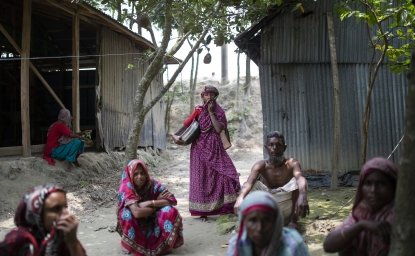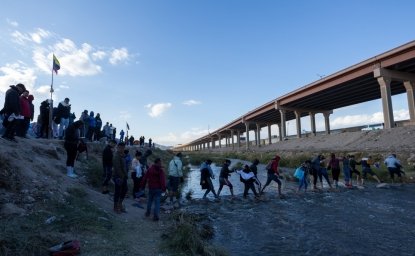Climate change has become part of our daily lexicon. Rarely does a week pass when a hurricane, drought, wildfire, or some other climate disruption is not front page news. These headlines often offer dire predictions of mass migration as well—a bracing vision of hordes of people moving to greener pastures, often found further inland and further north, where some political leaders leverage the narrative to push their own agendas.
Yet what is lost in these generalized narratives (and the accompanying political rhetoric) is the intricacies of the lived experience of the people and the communities most directly affected by climate change.
Climate change is in fact driving people’s decisions to move.
Climate change is in fact driving people’s decisions to move. But it does so in dynamic and complex ways interwoven with more traditional drivers of migration: a search for economic or educational opportunities, the tug of social and familial ties, or to escape conflict or avoid persecution.
Why does this distinction matter? Because finding the right response depends on getting the story right.
This report offers a more nuanced understanding. Working with veteran environmental journalist, Peter Schwartzstein, the Wilson Center set out to demystify and dispel wrong-headed narratives around climate and migration. Our narrative also gives voice to the people most affected by climate’s impacts, and points the way toward more strategic responses.
What Schwartzstein discovered in his cross-regional reporting on climate-related migration in Senegal, Bangladesh, and Moldova underscores some things that we already know. But they do bear repeating. People prefer to stay put on the land they know—and this is even more the case for those pushed to move by climate’s impacts. And the populations most at risk from migration related to climate change are also those most overlooked and marginalized by states.
Pursuing questions on climate and migration in at-risk nations also revealed that resilience building can take many shapes. For Tazara Begum in Bangladesh, forced to move from her native village to a slum in Dhaka, resilience starts with dignified housing. Senegalese herder Musa Ba has used loans from an area businessman to try and rebuild his stock against the odds. Nicolae Popov, an official in the Moldovan village of Cîrnățeni, attempts to stem the migrant flow by investing in local infrastructure. “If we act like a dying place,” he says, “we will be a dying place.”
As Popov’s story suggests, climate is not operating in a vacuum. Governance matters. How resources like land and water are managed matters. The strength and weaknesses of social bonds within and among communities matter. These dynamics also provide strategic entry points for designing interventions that make it possible for people to stay on their land, or—if they make the choice to move—to allow for dignified, safe, and affordable movement.
How many people does a village have to lose before it can no longer sustain itself?
These stories from Senegal, Bangladesh, and Moldova surface new insights, too. The decisions to move are spurred more often by climate unpredictability than scarcity. Unforeseen climate effects also play havoc with the continuing viability of communities and villages. How many people does a village have to lose before it can no longer sustain itself? The answer is varied and difficult to know.
Schwartzstein’s reporting also highlights the dynamics of what he calls the “fear factor” of migration. Apprehension about the outcomes of a move can deter migration, but when this “fear factor” is broken—often by a history of outmigration and established familial and social ties in the receiving community—climate-related migration tends to increase. These elements play a key role in migration patterns in Bangladesh and Moldova, but are less present in some communities in Senegal, where pastoralists lack the support networks established by migrant histories.
Technology cuts both ways in helping (or deterring) communities as they navigate the fallout from climate change. Schwartzstein discovered that in Senegal and Bangladesh, for example, properly targeted and accurately presented information via radio has proven valuable. Yet he also observed that “rampant” disinformation and misinformation complicates an already-problematic terrain in for Moldova.
The migratory narratives examined in our report also suggest broader lessons about the relationship between climate and migration. Schwartzstein’s examination of Moldova’s more than two centuries of populations on the move—paired with the impact of Russia’s war in Ukraine and an emerging climate crisis—offers a possible window into the future for other nations and regions where the past migration narratives now collide with increasingly urgent climactic and political pressures. The parallels on offer are both useful and striking.
Having to adapt to change is nothing new for those on the frontlines of climate change.
Having to adapt to change is nothing new for those on the frontlines of climate change. Yet the increasing speed and widening scale of change is proving to be beyond what is what is manageable by any stretch of the imagination—especially for many populations that are in no way responsible for creating these destructive forces.
Recognizing this fact—and clearly articulating its causes, patterns and outcomes— allows us to see climate migration for what it is: a story of remarkable adaptation and one that needs and deserves to be told accurately. A vivid and authoritative account can create the momentum needed to invest in responses that actually strengthen the resilience of those most affected.
Author


Environmental Change and Security Program
The Environmental Change and Security Program (ECSP) explores the connections between environmental change, health, and population dynamics and their links to conflict, human insecurity, and foreign policy. Read more

Explore More
Browse Insights & Analysis
Climate & Migration





